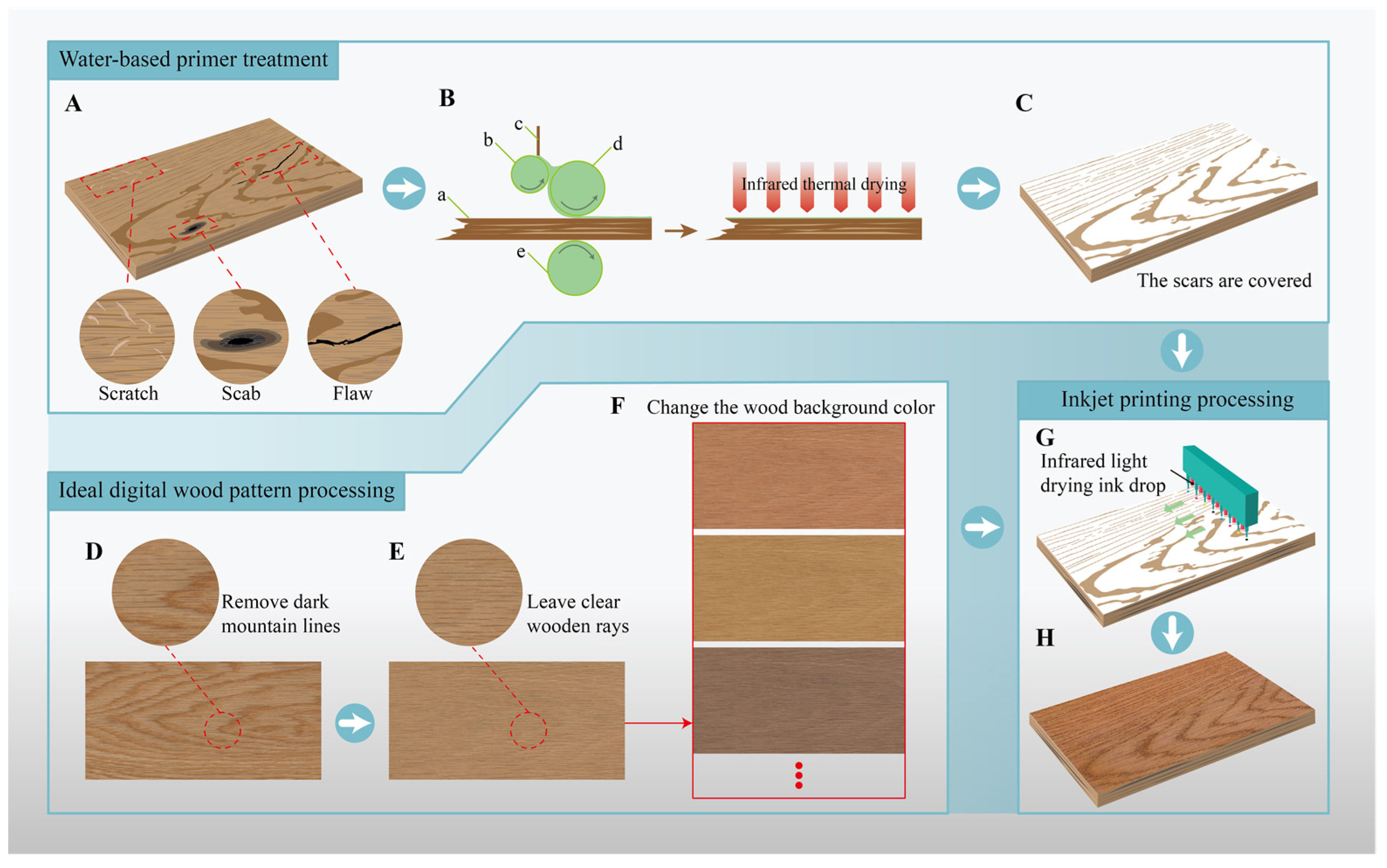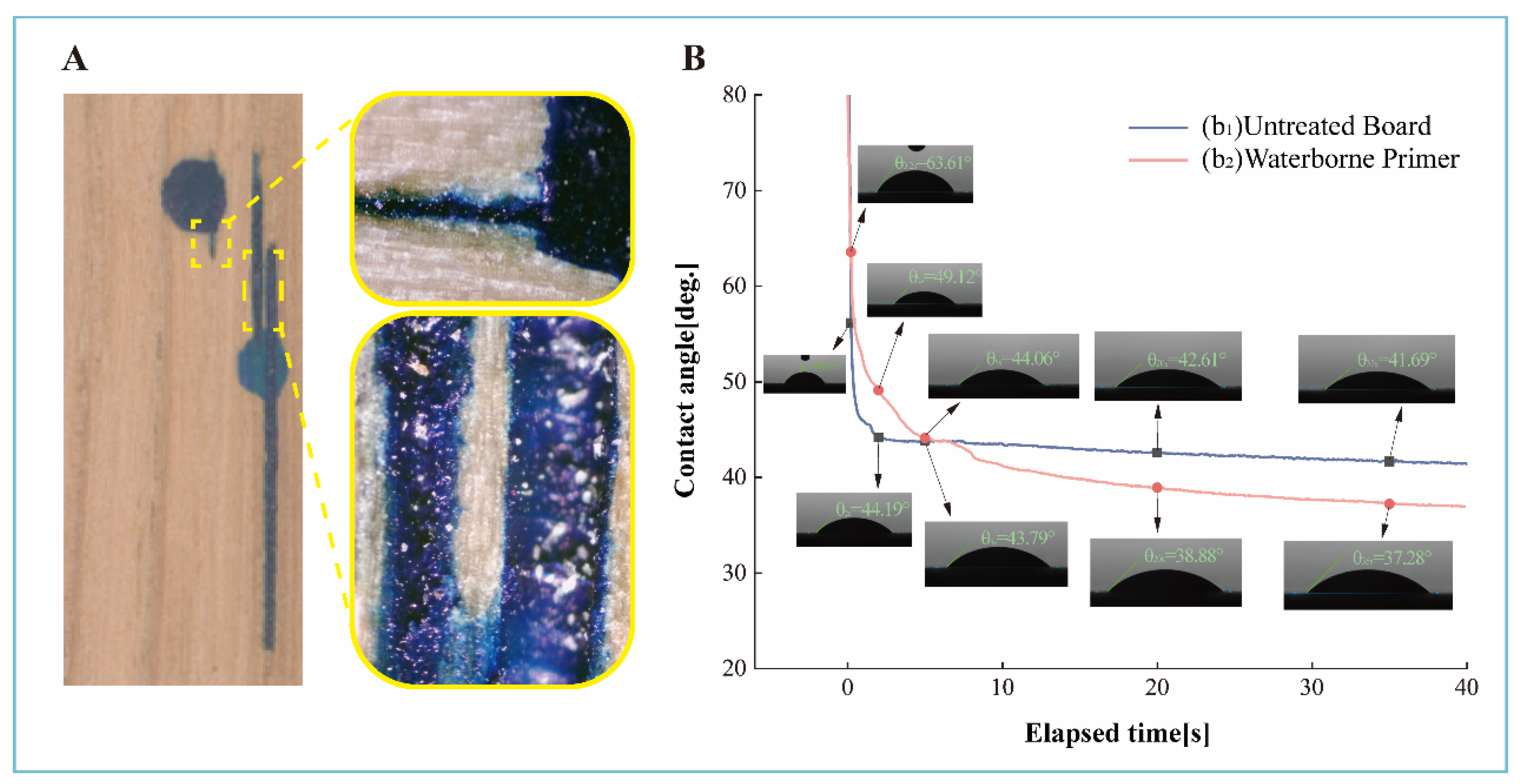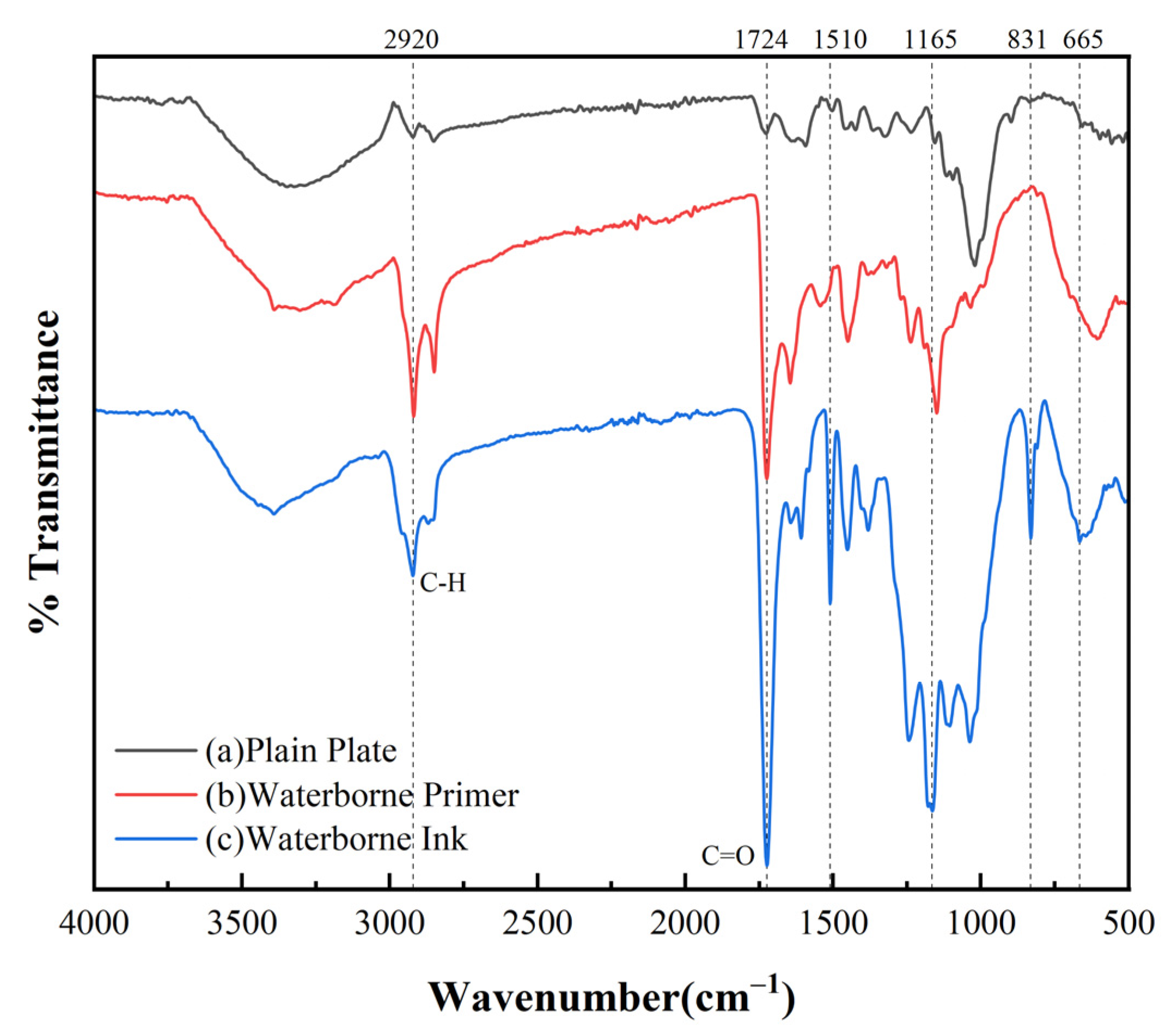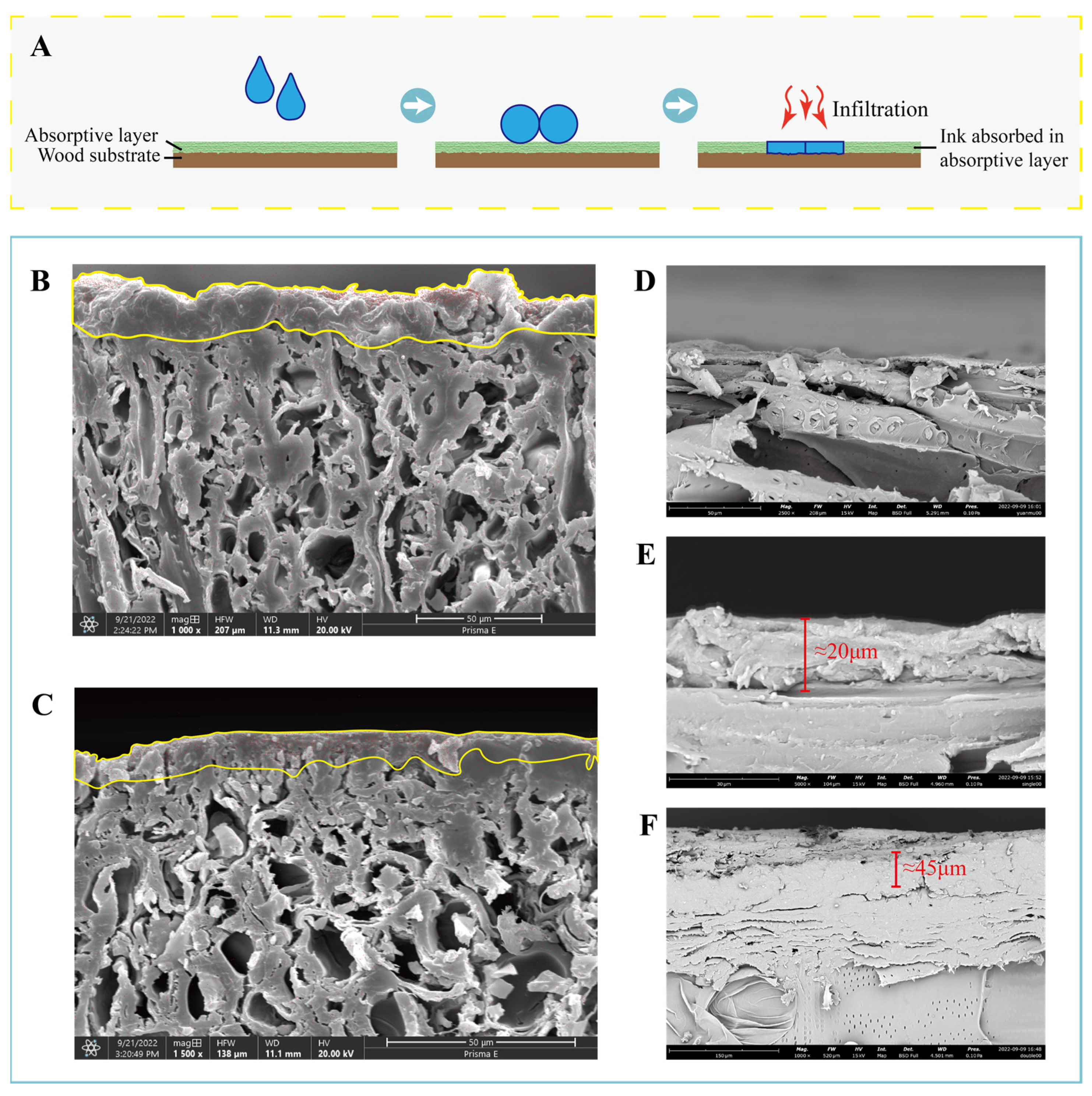The Effect of Water-Based Primer Pretreatment on the Performance of Water-Based Inkjet Coatings on Wood Surfaces
Abstract
:1. Introduction
2. Materials and Methods
2.1. Materials, Equipment and Software
2.2. Description of Roller Coating Process of Water-Based Primer
2.3. Waterborne Inkjet Printing Wood Grain Process
2.4. Surface Wettability Test
2.5. Infrared Spectroscopy
2.6. SEM and EDS Analysis
2.7. Measurement of Ink Dot Distribution under an Optical Microscope
2.8. Performance Test of Waterborne Primer Coating
3. Results and Discussion
3.1. Analysis of Wood Surface Wettability
3.2. FTIR Spectroscopy
3.3. SEM Morphology and EDS Element Analysis
3.4. Microscopic Distribution Characteristics of Ink Dots
3.5. Performance Analysis of Water-Based Primer Film
4. Conclusions
Author Contributions
Funding
Institutional Review Board Statement
Informed Consent Statement
Data Availability Statement
Conflicts of Interest
References
- Hu, W.-G.; Luo, M.; Hao, M.; Tang, B.; Wan, C. Study on the Effects of Selected Factors on the Diagonal Tensile Strength of Oblique Corner Furniture Joints Constructed by Wood Dowel. Forests 2023, 14, 1149. [Google Scholar] [CrossRef]
- He, L.; Ren, R.; Wang, L.; Zhou, J.; Ling, K.; Li, J.; Chen, S.; Chen, Y. Construction of layered double hydroxides on wood surfaces for wood coloring. Ind. Crops Prod. 2023, 198, 116661. [Google Scholar] [CrossRef]
- Sang, R.; Manley, A.J.; Wu, Z.; Feng, X. Digital 3D Wood Texture: UV-Curable Inkjet Printing on Board Surface. Coatings 2020, 10, 1144. [Google Scholar] [CrossRef]
- Zhao, Z.; Zhang, X.; Lin, Q.; Zhu, N.; Gui, C.; Yong, Q. Development and investigation of a two-component adhesive composed of soybean flour and sugar solution for plywood manufacturing. Wood Mater. Sci. Eng. 2022, 18, 884–892. [Google Scholar] [CrossRef]
- Ma, X.; Zhao, S.; Tian, Z.; Duan, G.; Pan, H.; Yue, Y.; Li, S.; Jian, S.; Yang, W.; Liu, K.; et al. MOFs meet wood: Reusable magnetic hydrophilic composites toward efficient water treatment with super-high dye adsorption capacity at high dye concentration. Chem. Eng. J. 2022, 446, 136851. [Google Scholar] [CrossRef]
- Scotton, R.S.; Guerrini, L.M.; Oliveira, M.P. Evaluation of solvent-based and UV-curing inkjet inks on the adhesion and printing quality of different aircraft surfaces coating. Prog. Org. Coat. 2021, 158, 106389. [Google Scholar] [CrossRef]
- Sang, R.; Yang, S.; Fan, Z. Effects of MDF Substrate Surface Coating Process on UV Inkjet Print Quality. Coatings 2023, 13, 970. [Google Scholar] [CrossRef]
- Badila, M.; Dolezel-Horwath, E.; Zikulnig-Rusch, E.M.; Schmidt, T.; Kandelbauer, A. Evaluation of the compatibility between low pressure melamine (LPM) film printing substrates and inkjet inks. Eur. J. Wood Wood Prod. 2012, 70, 639–649. [Google Scholar] [CrossRef]
- Simon, J.; Langenscheidt, A. Curing behavior of a UV-curable inkjet ink: Distinction between surface-cure and deep-cure performance. J. Appl. Polym. Sci. 2020, 137, 49218. [Google Scholar] [CrossRef]
- Yu, M.J.; Huang, B.Q.; Wei, X.F. Research of the Factor that Influence the Glossiness of Water-Based Tipping Paper Gravure Varnish. Appl. Mech. Mater. 2012, 262, 426–429. [Google Scholar] [CrossRef]
- Huang, W.T.; Chen, G.X.; Tang, B.L.; Yu, M.G. Study on Preparation and Property of Acrylic Resins Used for Water-Based Ink. Appl. Mech. Mater. 2012, 262, 491–496. [Google Scholar] [CrossRef]
- Kuo, C.-H.; Shiu, J.-W.; Rwei, S.-P. Preparation and characterization of PMMA encapsulated carbon black for water-based digital jet printing ink on different fibers of cotton and PET. Colloids Surf. A Physicochem. Eng. Asp. 2022, 648, 129450. [Google Scholar] [CrossRef]
- Gao, C.; Zhang, Z.; Xing, T.; Hou, X.; Chen, G. Controlling the micro-structure of disperse water-based inks for ink-jet printing. J. Mol. Liq. 2020, 297, 111783. [Google Scholar] [CrossRef]
- Yan, X.; Wang, L.; Qian, X. Effect of Microcapsules with Different Core–Wall Ratios on Properties of Waterborne Primer Coating for European Linden. Coatings 2020, 10, 826. [Google Scholar] [CrossRef]
- Liang, L.; Chen, Z.; Hao, H.; Hu, K.; Wei, X. Fabrication and Performance of Water-Based Near-Infrared Absorption Ink-Jet Ink. Adv. Graph. Commun. Packag. Technol. Mater. 2016, 369, 927–933. [Google Scholar]
- Yan, X.; Li, W.; Han, Y.; Yin, T. Preparation of Melamine/Rice Husk Powder Coated Shellac Microcapsules and Effect of Different Rice Husk Powder Content in Wall Material on Properties of Wood Waterborne Primer. Polymers 2021, 14, 72. [Google Scholar] [CrossRef]
- Yan, X.; Pan, P. Preparation of Silver Antibacterial Agents with Different Forms and Their Effects on the Properties of Water-Based Primer on Tilia europaea Surface. Coatings 2021, 11, 1066. [Google Scholar] [CrossRef]
- Gu, S.H.; Ji, H.Y.; Liang, K.; Ji, Y.L. Chitin nanocrystal based aqueous inks for 3D printing via direct ink writing. J. Elastom. Plast. 2022, 54, 922–936. [Google Scholar] [CrossRef]
- Liu, K.; Liang, H.; Nasrallah, J.; Chen, L.; Huang, L.; Ni, Y. Preparation of the CNC/Ag/beeswax composites for enhancing antibacterial and water resistance properties of paper. Carbohydr. Polym. 2016, 142, 183–188. [Google Scholar] [CrossRef]
- Bhagavathi, L.R.; Deshpande, A.P.; Ram, G.D.J.; Panigrahi, S.K. Effect of cellulosic fillers addition on curing and adhesion strength of moisture-curing one-component polyurethane adhesives. Int. J. Adhes. Adhes. 2021, 108, 102871. [Google Scholar] [CrossRef]
- Li, Y.; Jin, Y.; Zeng, W.; Zhou, R.; Shang, X.; Shi, L.; Bai, L.; Lai, C. Mechanically robust and fast room-temperature self-healing waterborne polyurethane constructed by coordination bond and hydrogen bond with antibacterial and photoluminescence functions. Prog. Org. Coat. 2023, 174, 107256. [Google Scholar] [CrossRef]
- Tian, C. Orthogonal interactions and synergistic effects of salt treatment and calcination on rutile titanium dioxide pigment preparation. Mater. Chem. Phys. 2020, 249, 123125. [Google Scholar] [CrossRef]
- Farrokhpay, S. A review of polymeric dispersant stabilisation of titania pigment. Adv. Colloid. Interface Sci. 2009, 151, 24–32. [Google Scholar] [CrossRef] [PubMed]
- Zhang, K.; Fang, K.; Sun, F.; Song, Y.; Qin, H. The hydrophobicity and swelling of methyl cellulose coating synergistically enhancing the inkjet printing qualities of cotton fabric. Prog. Org. Coat. 2022, 173, 107187. [Google Scholar] [CrossRef]
- GB/T 4893.4-2013; Test for Physical and Chemical Properties of Paint Film on Furniture Surfaces—Part 4: Determination of Adhesion by Cross Cutting. Standards Press of China: Beijing, China, 2013.
- GB/T 6739-2006; Paint and Varnish Pencil Method to Determine the Hardness of Paint Film. Standards Press of China: Beijing, China, 2007.
- Liu, Z.; Fang, K.; Gao, H.; Liu, X.; Zhang, J. Effect of cotton fabric pretreatment on drop spreading and colour performance of reactive dye inks. Color. Technol. 2016, 132, 407–413. [Google Scholar] [CrossRef]
- Khosravi, S.; Nordqvist, P.; Khabbaz, F.; Öhman, C.; Bjurhager, I.; Johansson, M. Wetting and film formation of wheat gluten dispersions applied to wood substrates as particle board adhesives. Eur. Polym. J. 2015, 67, 476–482. [Google Scholar] [CrossRef]
- Lin, Q.; Zhang, X.; Zhu, N.; Kusumah, S.S.; Umemura, K.; Zhao, Z. Preparation and investigation of an eco-friendly plywood adhesive composed of sucrose and ammonium polyphosphate. Wood Mater. Sci. Eng. 2022, 18, 1202–1211. [Google Scholar] [CrossRef]
- Magdassi, S. The Chemistry of Inkjet Inks; World Scientific: London, UK, 2010. [Google Scholar]
- Middlemas, S.; Fang, Z.Z.; Fan, P. A new method for production of titanium dioxide pigment. Hydrometallurgy 2013, 131–132, 107–113. [Google Scholar] [CrossRef]
- Leelajariyakul, S.; Noguchi, H.; Kiatkamjornwong, S. Surface-modified and micro-encapsulated pigmented inks for ink jet printing on textile fabrics. Prog. Org. Coat. 2008, 62, 145–161. [Google Scholar] [CrossRef]






| No. | Experimental Materials | Molecular Formula |
|---|---|---|
| 1 | H2O | H2O |
| 2 | Waterborne polyurethane resin | |
| 3 | PH regulator | - |
| 4 | Defoamer | - |
| 5 | Propylene glycol | C3H8O2 |
| 6 | Wetting agent | - |
| 7 | Dispersant | - |
| 8 | TiO2 | TiO2 |
| 9 | Thickening agent | - |
| 10 | Acrylic lotion | C3H4O2 |
| 11 | Anti-settling agent | - |
| 12 | Film-forming aids | - |
| 13 | Foam inhibitor | - |
| 14 | Fungicide | - |
| Product Name | Product Model | Coating Amount/g/m2 | Roll Coating Times | Remarks |
|---|---|---|---|---|
| Waterborne white primer | WD4500A | 15 | 2 | Double cots/IR drying |
| Sample | Adhesion | Glossiness | Hardness | Roughness | Film Whiteness |
|---|---|---|---|---|---|
| water-based primer roller coating | Level 1 | 5.6 | 2H | 2.516 | 66.6 |
Disclaimer/Publisher’s Note: The statements, opinions and data contained in all publications are solely those of the individual author(s) and contributor(s) and not of MDPI and/or the editor(s). MDPI and/or the editor(s) disclaim responsibility for any injury to people or property resulting from any ideas, methods, instructions or products referred to in the content. |
© 2023 by the authors. Licensee MDPI, Basel, Switzerland. This article is an open access article distributed under the terms and conditions of the Creative Commons Attribution (CC BY) license (https://creativecommons.org/licenses/by/4.0/).
Share and Cite
Sang, R.; Yang, F.; Fan, Z. The Effect of Water-Based Primer Pretreatment on the Performance of Water-Based Inkjet Coatings on Wood Surfaces. Coatings 2023, 13, 1649. https://doi.org/10.3390/coatings13091649
Sang R, Yang F, Fan Z. The Effect of Water-Based Primer Pretreatment on the Performance of Water-Based Inkjet Coatings on Wood Surfaces. Coatings. 2023; 13(9):1649. https://doi.org/10.3390/coatings13091649
Chicago/Turabian StyleSang, Ruijuan, Fei Yang, and Zhenxian Fan. 2023. "The Effect of Water-Based Primer Pretreatment on the Performance of Water-Based Inkjet Coatings on Wood Surfaces" Coatings 13, no. 9: 1649. https://doi.org/10.3390/coatings13091649
APA StyleSang, R., Yang, F., & Fan, Z. (2023). The Effect of Water-Based Primer Pretreatment on the Performance of Water-Based Inkjet Coatings on Wood Surfaces. Coatings, 13(9), 1649. https://doi.org/10.3390/coatings13091649






